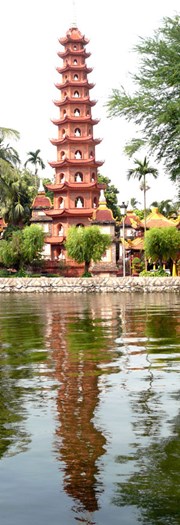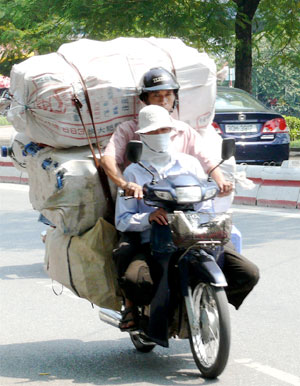HANOI - It was just past 7 a.m. but already the streets of Hanoi’s Old Quarter were clogged with thousands of noisy little motor scooters, the transportation of choice for the six million citizens of this lovely capital, also known as the City of Lakes.
Every traffic light here looks like the starting line of a Grand Prix motorcycle race as scooter drivers line up across wide French-designed boulevards and rev their engines in anticipation of the green light.
There are an estimated five million scooters in Hanoi and about 20 million in all of Viet Nam, making this country of 83 million people the motor scooter capital of the world.
In a city practically void of public transportation – no subway and only Soviet-era buses to get millions of commuters around – the motorized bikes make perfect sense, unless, of course, you’re a pedestrian trying to make your way across the network of narrow streets that make up the working class Old Quarter.
“Just walk slowly,” Doan Cong Dinh, my guide, advised as we started across an intersection known as Hang Bac. “The scooters will make their way around you, no problem. Just don’t run or they will not be able to anticipate your moves.” We made it safely across but others are not so lucky. Dinh told me over 12,000 people are killed each year here in motor scooter accidents.
That’s when I declined his offer to show me the city from the back of his motor scooter.
“Okay, we will see Hanoi on foot – it’s very walkable,” said Dinh as we started out on our tour of this city that has served as the capital of a unified Vietnam since the early 1980s, but whose roots go back many centuries.
The Vietnamese are of Chinese decent and for over 1,000 years China ruled this country that had long periods of conflict with its neighbours and foreign occupiers.
The French colonized Vietnam more than 100 years ago and made Hanoi the capital of its Indochina Empire which also included Cambodia and Laos. During World War II, Japan occupied Vietnam, a terrifying period when 10 per cent of the population starved to death. Then came the Vietnam War with the United States which changed the history of this lovely country forever. When the Americans abandoned South Vietnam in the early 1980s, Ho Chi Minh unified the country under the communist banner. Since 1984, Vietnam has lived in peace - one of the longest periods without conflict in this country’s history.
“We will walk through the Old Quarter to get to the Ho Chi Minh Mausoleum,” said Dinh as we headed for Independence Square and the granite tribute to Ho Chi Minh, the little man who made such a big impact on the world during his life. After his death at age 69, Ho Chi Minh’s embalmed body was placed in a glass case within the cold, grey mausoleum and put on display for his subjects. The mausoleum is open between 7:30 a.m. and 10:30 a.m. each day except Mondays and Fridays, and attracts thousands who wait silently in usually oppressive heat to view the leader who came to prominence here in the 1940s. Although long, the line moved steadily and in less than 30 minutes Dinh and I had had past the glass coffin continually watched over by an honour guard from the People’s Army.


Above: Hanoi is a city of lovely temples and lots and lots of noisy scooters.
The square in which the mausoleum sits is surrounded by a number of attractive buildings, the most beautiful of which is the gold-coloured Presidential Palace, built by the French for their first Indochina governor. The building is now used for greeting visiting heads of states.
“They wanted Ho Chi Minh to live there when he was in power but he refused and lived in a simple house at the back of the property,” said Dinh.
The smaller home, where the powerful Ho Chi Minh lived and worked alone surrounded by simple trappings, is bordered by a small lake and gardens and is impressive in its own right. On the opposite side of the lake is another home, built for Ho Chi Minh in his later years, “and it has air conditioning,” said Dinh.
Although he never married, Dinh told me in a whisper: “There are many people walking around Vietnam who look very much like Ho Chi Minh.”
In the same complex is the city’s famed One Pillar pagoda, which dates back almost to the time Hanoi was first settled in 111 BC.
Our visit to the complex completed, Dinh suggested we return to the Old Quarter where we could shop and enjoy a bowl of pho – Vietnam’s national dish made of rice noodles that comes swimming in a rich broth and is topped with beef (usually), chicken or fish. Pho costs just $1 U.S. at neighbourhood eateries and makes for an ample lunch or dinner. The Vietnamese even eat it at breakfast.
The streets of the Old Quarter were now clogged with delivery trucks and scooters, both of which were spewing choking fumes. The polluting emissions make your eyes and throat sore after a while and can even cause headaches.
“Look at the family sandwich,” said Dinh as a scooter passed with an entire family of four (father, mother and two small children) sandwiched on the small vehicle. “We call it a sandwich when the kids are placed between the parents.”
The Old Quarter is one of three major districts in Hanoi – the others are the French Quarter and Government Quarter. Much of the city’s commerce is conducted on the streets of the Old Quarter in much the same way it has been done for centuries.
Hanoi, which “gives you a much better insight into traditional Vietnamese life more so than the more cosmopolitan Ho Chi Minh City (formerly Siagon),” according to Dinh, is a city of bargains and the world’s largest dollar store, with most items, including handmade lacquer paintings, granite sculptures and clothing being sold in shops for just $1 U.S.
Hanoi is also another Asian knockoff centre with well done copies of designer goods being offered in public markets. “The copies here are the best in Asia – especially the art,” Dinh told me.
In the morning, tiny women balancing overstuffed baskets of fruits and vegetables on a mobile shop called quang ganh (two wicker baskets carried with a bamboo stick) on their backs patrol the Old Quarter hoping to find buyers for their produce. In the afternoon, those same women switch to selling souvenirs and then later help pick up garbage with their baskets. The congested streets of the Old Quarter are named after what is sold on them – Bamboo St., Silver St., Bronze St., etc. The most fascinating street was Comb St., where once special combs were made to get lice out of people’s heads.
“We don’t have that problem anymore,” Dinh assured me.
Although still called Comb St., the narrow artery now features vendors offering children’s toys. And there are a lot of young customers in Hanoi, a city where 65 per cent of the population is under 30 years of age and 50 per cent are younger than 25.
“After the war with the U.S., Vietnam, and especially the North, experienced a baby boom,” said Dinh.
Not far from the Old Quarter is charming West Lake, the most impressive of Hanoi’s 10 lakes. Hanoi residents gather on the shore of the lovely waterway to sip the country’s famed coffee on the decks of anchored boats and stroll through the surrounding park where one of the city’s major icons, the Tran Quoc Pagoda is located.
The other major lake in Hanoi is Hoan Kiem, where a floating stone temple attracts many visitors in he evenings. There are countless neighbourhood parks in the city and that has earned Hanoi special recognition from the United Nations as one of the world body’s “Green Cities.”
The French Quarter is the loveliest section of the city. The cornerstone of the district is the city’s cream-coloured Opera House, fashioned after Paris’ famed Opera Garnier. It was built by the French in 1911 and seems to look better with age. No building in the French Quarter can be taller than the impressive Opera House, which wedding parties use as a backdrop for their photographs.
Another striking edifice in the French Quarter is the Metropole Hotel, a holdover from the French Empire era. It remains the city’s top hotel. Many French influences remain in this city, including tree lined boulevards and outdoor cafes.
One of Hanoi’s most interesting features is the narrow homes which occupy its streets. Most of the homes here are no wider than four metres but have three to four storeys and are all painted vibrant colours – the most popular being gold because it reflects the royal colour used by the countries ancient dynasties.
“There is very little space in Hanoi so our homes must be vertical,” said Dinh. “The bottom floor is reserved for the family’s business and the upper floors are where the family lives.”
Vietnam is the fastest growing economy in Asia after China but much of that prosperity has yet to reach the people living on the capital’s cramped streets.
“The average salary here is about $70 U.S. a month but the cost of living in Hanoi is around $300 a month so most people are forced to work several jobs and there is a large black market here,” said Dinh.
Life on Hanoi’s streets hasn’t changed much over the centuries. Ice is still delivered in blocks on the shoulders of burly young men; unrefrigerated meat is sold uncovered in steamy fly-infested markets; and haircuts are done right on the street at a cost of just $2 U.S.
Other highlights we saw while walking around Hanoi were Lenin Square, where a statue of the former Soviet leader whom Ho Chi Minh admired casts a shadow on an impressive parcel of real estate across from the country’s Military Museum where an old Russian Mig Fighter, which played such a major part in the war with the U.S., stands guard.
The country’s first university, the Temple of Literature, a 1,000-year-old national treasure which features manicured gardens and lovely lotus filled ponds, offers visitors a tranquil place to escape the chaos of Hanoi’s streets, where a continuous symphony of annoying car and scooter horns irritates everyone.
“If a driver’s horn was not working, they would not know how to drive,” said Dinh.
After one visit to this enchanting city, though, you can appreciate why people blow their own horns.
Information
- Our favorite hotels in Hanoi: The Softitel Metropole; the Hilton, the Sheraton and the Sofitel Plaza.
- Favorite restaurants: Bobby Chinn (western and Vietnamese fusion), 1 Ba Trieu St., Hoan Kiem District, (84-4) 934 8577 (ask for a window seat that looks out on Hoan Kiem lake); and our Vietnamese dining favorites were Le Tonkin, 14 Ngo Van So, Hoan Kiem, (84-4) 9433 457; Nam Phuong, 19 Phan Chu Trinh (84-4) 824-0926.
- Our favorite districts: The French and Old Quarters.